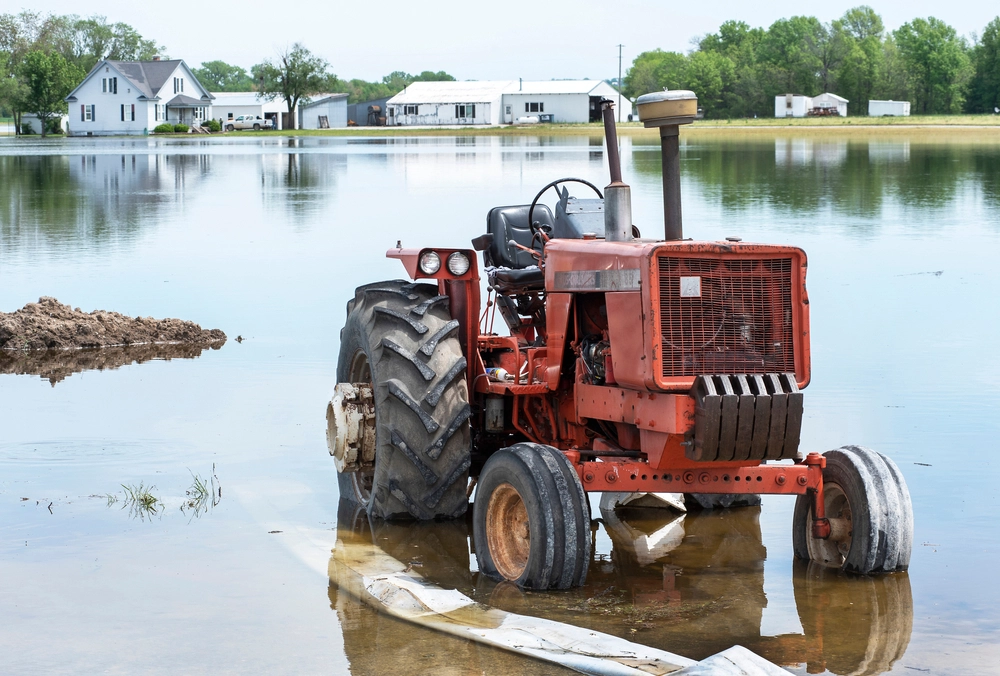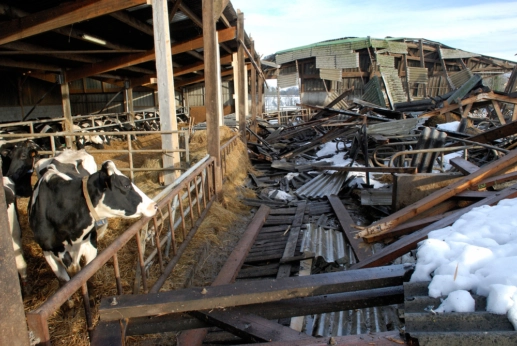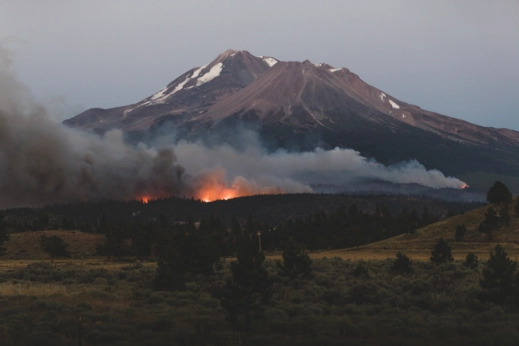Extreme weather events are happening more often and with more intensity. Surviving them is a multi-year process.

In 2007, Abbie Corse got a message every farmer dreads: “Are your animals ok?”
At the time, Corse was working off farm, while her parents transitioned their dairy into an organic operation. Corse, panicking, called her parents to find out that a fire had ripped through their barn. Luckily, they were able to move their animals out in time, but the recovery period was brutal. Corse’s parents settled their 100-head herd with a neighbor, driving the 20 miles each way twice a day, for months, to milk and care for the cows. Corse and her siblings had heart-wrenching discussions about if the barn was worth rebuilding, as her parents were getting close to retirement. But Corse didn’t want the farm to disappear. So, she rebuilt the barn and took over the operation, the sixth generation to run the Vermont dairy.
As a dairy farmer, Corse has to prepare for fires, floods and all sorts of extreme weather disasters that can impact her animals and her business. She’s seen lightning strikes, 90-mile–per-hour wind storms and hurricane-level rain. “From a farmer’s perspective, there’s an incredible breadth of challenges that are coming because of extreme weather. And they’re incredibly unpredictable,” says Corse. “As you’re structuring your cropping and the livestock rotations, you’re having to actively adapt, sometimes daily, to deal with the weather conditions.” In order to deal with those challenges, Corse does have some contingency plans in place. She has a trailer that can fit some of her animals and enough pasture that she’s hopeful she’ll be able to find space for her cows. But the trauma of that fire stays with her, even now. “If that happened right now, I don’t know that I could continue,” says Corse. “I cannot overemphasize the strain from holding all of this stuff coming at you as a farmer.”

Photography by Leitenberger Photography/Shutterstock
The impacts of extreme weather events and disasters on agriculture have been nearly unbelievable in some areas. Wildfires in California burned up more than 4.2 million acres in 2020 and, in 2017, damaged the wine grape harvest, resulting in an economic loss of roughly $75 million for the state. The 2021 heat dome that covered British Columbia saw temperatures rise as high as 121 degrees Fahrenheit, or nearly 50 degrees Celsius. The oppressive heat caused roads to buckle and more than 500 deaths across the region. Across farmland in the lower parts of the province, producers dealt with the deaths of thousands of animals, including more than 630,000 chickens, while 2,500 acres of blueberries wilted. Hurricanes in Florida have wrecked orange groves, causing losses of more than $247 million to the economy.
As we reckon with the impacts of climate change, these extreme weather events will happen more frequently and with more intensity. Experts say we can expect to see more extreme cases of both flooding and drought, storms with higher winds and fires start and spread more rapidly. This has impacts on the health of soils and coastal waters, both of which are critical to the health and prosperity of our food supply.
The stress and strain of an emergency evacuation can be a lot to think about head on. It’s painful to think about the potential losses of an emergency or how you might manage hundreds of animals in your rush out the door. But no matter your situation, the best thing you can do, says Ragan Adams, the veterinary specialist for the Colorado State University extension, is to make a plan and practice it, to get your livestock used to the motions. Animals, says Adams, are “aware of something changing in nature and around them. If they’re domestic pets, they’ll usually pick up from you if something’s wrong and begin to worry…There’s this saying in the world of animals that the slower you go, the faster you get things done. The slower you go, the less stressed you seem, the easier it is for the animals.” Also key in an emergency, says Adams, is a steady communication source that isn’t a cellphone (those towers can go down in a storm) and a reliable method of transportation that is gassed up and ready to go. Learn more about preparing for an emergency at the farm here.
A 2011 paper from the USDA estimated that, at the time, the roughly 90 extreme weather-related disasters in the previous 30 years had resulted in more than $700 billion in normalized losses. “Droughts, floods, hurricanes, severe storms, heat waves, freezes and wildfires pose serious challenges for farmers and the agribusiness community,” writes author Raymond Motha. “Socio-economic costs of some of these natural disasters are far-reaching and long-lasting. The enduring changes in climate, water supply and soil moisture necessitate mitigation measures and adaptation strategies to cope with these changes in order to develop effective long-term risk management plans.”
Livestock producers and ranchers have a lot to deal with during a disaster, but crop farmers face a range of long-term impacts from weather events. Extreme precipitation, meaning heavy amounts of rain or snow falling in a short period of time, can cause crop damage and soil erosion. It can also lead to an increase in flooding, while runoff from all that water can add to pollutants in the streams and water supply. During droughts, soils can dry out, and heavy winds can strip or rearrange placements of that protective layer of topsoil. Building up that top layer of soil by cover cropping, or practicing no-till farming, can help protect the soil’s structure, but with more frequent wind and storm events, it’s getting harder to maintain that solid foundation.

Fire burns on the northwest side of Mount Shasta in Siskiyou County, California. Photography by Trevor Bexon/Shutterstock.
A colleague of Adams’s, Scott Cotton, has dealt with weather emergencies for close to 30 years. Now retired, he still consults with the Extension Disaster Education Network (EDEN), which developed after devastating floods in Mississippi and Missouri in 1993. The group now works with educators and citizens to prepare for emergencies and learn from them.
One of the best things ag producers and farmers can do in advance of an emergency is work with the local agency in charge of disaster management, says Cotton. Whether that’s Emergency Medical Services, fire services or law enforcement, Cotton says their initial tendency in disasters is to shut down roads, limit access to areas and prioritize public safety. For a livestock producer who has poured his whole life and career into building his herd, he may not want to hear that he has to leave the animals behind. “That’s his life. It means everything. It’s his identity, his economic flow,” says Cotton. He’s seen those same producers, then, ignore directives from law enforcement and try to go around a blockade or cut a fence to move around it. Without proper communication with local agencies, those farmers can get stranded or stuck on a washed-out road or behind the fire line. Conversely, though, when producers and agencies make evacuation plans together ahead of time, it can make everything run smoother. “It takes the weight off of the emergency manager, because there is a team out there that knows what they’re doing,” says Cotton. “Nobody knows the landscape better than producers. So, when [EMS] needs a secondary access point in the area, and how to get around a blockage, producers know the way. If they’re in communication, it makes a difference.”
No matter how prepared you are, though, it takes a long time to recover after a disaster. There are four basic stages: preparation, mitigation (where teams work to reduce possible impacts), response and recovery. The weather event itself might have been a single day, but Cotton says the timeline of a disaster can run 10 to 12 years.
Cotton recalls an historic blizzard in 2013, where nearly five feet of snow fell on much of South Dakota over three days. “We had 496 producers, across 200 miles. And it was sheep and cattle and horses, most of them.” Cotton and his local team started sending out emergency road crews to open up main arteries and get in touch with producers to find out where their livestock was and how many they’d lost. It took weeks to get to everyone, and then snow was so deep that it took excavators to clear paths to bury animals that didn’t make it through the storm. One producer, Cotton recalls, an 82-year-old rancher, lost the majority of his sheep and cattle. “We brought in a plow and dug a big trench, and then we piled all of his dead cattle up and rolled it into the trench with the snowplow….The trauma of his family standing here watching this, putting their entire life in a ditch, is really extreme.” That’s why Cotton says the first thing to think about once the disaster has cleared is counseling. There are psychological burdens that go along with weather disasters, especially for farmers and producers who can watch their livelihoods get wiped out in an instant.
“We have producers who go out of business, not because they can’t refinance things, just because the emotional toll is so high from one or two events that they can’t handle it,” says Cotton. That’s what Corse was considering after the barn fire at her Vermont dairy in 2007. Ultimately, she decided to keep going, but she carries that trauma and stress with her every day now, and she sees it getting worse. “In a situation where, literally day to day, you’re having to adapt your entire plan as a farmer because the weather is changing that quickly…we’re not ready for this moment.”
This article hit very close to home. I am not a big producer with hundreds of head of livestock, but in 2008 we had a barn fire. Older insulation on some wiring was whipped around in the wind and sparked to start the fire. I was away at the time. The 85 year old barn was a total loss. Luckily I just lost some chickens and 3 of my goats got burned and recovered. The horses were fine. But it stays with you and is something you never forget. I now have a better plan in place and also pay… Read more »